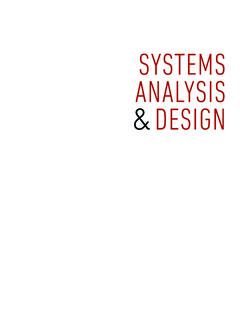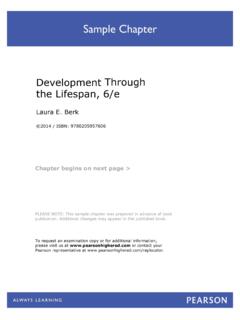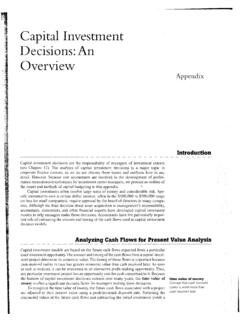Transcription of 8 Purchasing, Receiving, Storing, and Issuing - Pearson
1 8. Purchasing, Receiving, Storing, and Issuing Inside This Chapter Professional Beverage Management Practices Beverage Inventory Assessment Purchasing Beverages Receiving Beverages Storing Beverages Issuing Beverages Chapter Learning Objectives After completing this chapter, you should be able to: Explain the difference between D. escribe the purpose of an issue physical and perpetual inventory requisition. systems. Explain how to calculate an L ist the two key objectives of an inventory turnover rate.
2 Effective beverage purchasing program. Explain the purpose of effective beverage receiving and storage practices. 188 3/13/12 3:28 PM. Key Terms average inventory, first in, first out (FIFO), license state, p. 194. p. 207 p. 193 order point, p. 198. capital, p. 197 inventory turnover rate, perpetual inventory, cash flow, p. 197 p. 207 p. 192. control state, p. 194 last in, first out (LIFO), physical inventory, p. 191. p. 193. cost of goods sold (COGS), rotation, p. 201. p. 207 lead time, p. 198. safety level, p.
3 198. Case Study How can you run out of my favorite gin? , demanded the customer. Marco, the bartender at the Votive Restaurant, tried to explain. We really don't sell much of that brand. It looks like we forgot to restock it and we ran out. I can get you another brand.. Marco knew this guest, who was usually friendly and tipped well. But not today. Young man, grumbled the customer, getting up to leave, if I wanted bad gin, I would have gone somewhere else. I came here because you usually have the best bar selection in town.
4 This happens way too often, thought Marco. Last week we ran out of a premium vodka. And the week before that, we ran out of our most popular draft beer.. Both times some customers got mad, and it showed up in lower tips. Marco wondered why the manager couldn't keep the right products in the right amounts on hand at the right time. 1. How do you think the lack of popular beverages affects the customers and the employees of an establishment? 2. What will happen in an establishment if it continually runs out of the beverage brands or products its customers prefer?
5 189. 189 3/13/12 3:28 PM. CHAPTER 8 Purchasing, Receiving, Storing, and Issuing PROFESSIONAL BEVERAGE MANAGEMENT PRACTICES. Managers face a variety of challenges in securing and maintaining the products needed to serve drinks. They must consider which beverage products to buy. They must also consider the amount of beverage products needed to meet customer demand. After placing orders, managers must ensure that beverage products are properly received. The receiving process entails matching the products ordered with those delivered.
6 It also means ensuring that the products have arrived in good condition. After the product is delivered, managers must safely store products, Issuing them from storage as needed. The entire process of managing beverage products in storage involves several separate tasks: Inventory assessment Purchasing Receiving Storing Issuing Beverage Inventory Assessment Managers seeking to understand beverage purchasing, receiving, storing, and Issuing must begin by first understanding beverage inventory procedures.
7 Most operations will have several inventories. These inventories include alcoholic beverages, glassware and dishes, food items, nonalcoholic beverages, and cleaning and office supplies. An operation's inventory accounts for both the amount and the value of the products held in the operation. These inventory levels are also known in the industry as the amount on hand.. The quantity of products on hand impacts decisions about when and how much more to purchase. Beverage managers should assess their inventory levels on a regular basis .
8 The frequency of inventory assessment will vary based on the size of an operation. It will also depend on the operation's volume level. All beverage operations will benefit from a regular assessment of inventory, because the inventory process allows managers to make several key decisions related to the following: Maintaining product quality Determining what to buy Determining how much to buy 190. 190 3/13/12 3:28 PM. Beverage Inventory Assessment Determining when to buy Determining costs Reducing theft Restaurant and foodservice professionals often use two basic systems as they manage the products held in inventory: physical inventory and perpetual inventory.
9 Physical Inventory Managers typically assess the amount of products they have on hand by taking a physical inventory. In a physical inventory system, managers count and record the amounts of each product in storage. Typically, they also determine the value of the products held in inventory. In some operations, managers require that two people, working together, take the physical inventory. They do this to help ensure accuracy and to reduce control problems, such as theft. Exhibit shows a physical inventory form that identifies the information typically collected for each inventoried item.
10 Note that seven bottles of Old Hoshler whiskey were in the beverage storeroom when the manager took the inventory count. Each bottle has a purchase price of $ This was known because the cost per bottle was recorded when the product was delivered. Therefore, the total inventory cost of this product is $ : 7 $ $ Total bottles Cost per bottle Cost price Exhibit Physical Inventory Form Item Purchase Unit No. of Units Purchase Price Total Cost in Inventory Old Hoshler Whiskey Bottle (750 ml) 7 $ $ Joliet Gin Bottle (1 L) 4 Total $ 191.












